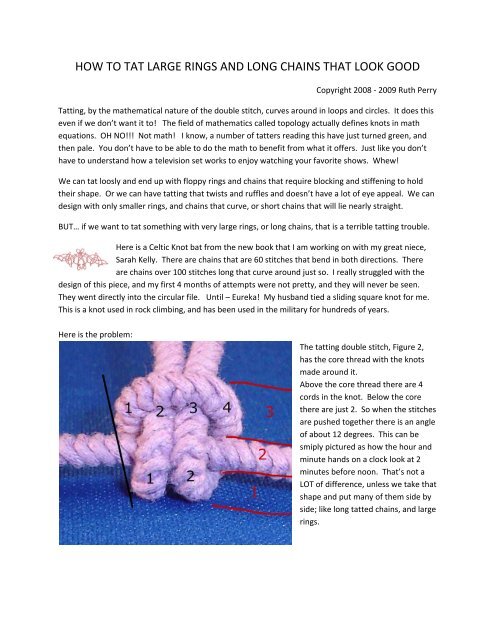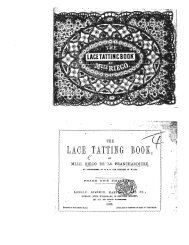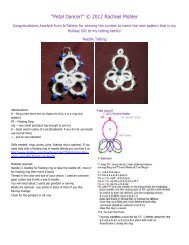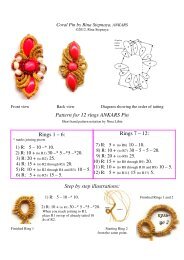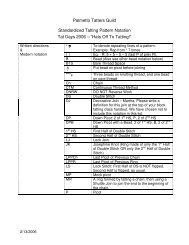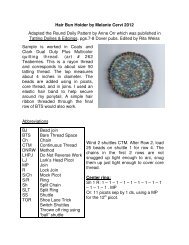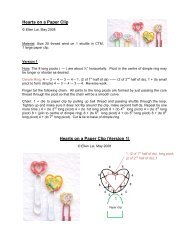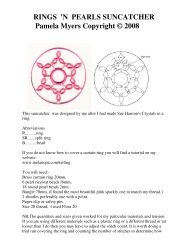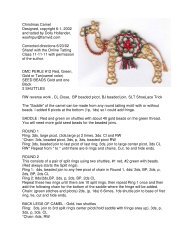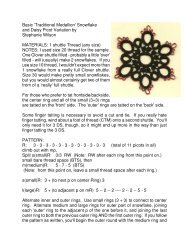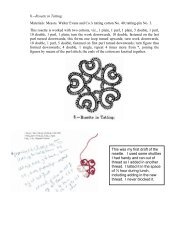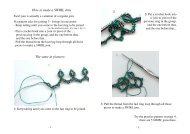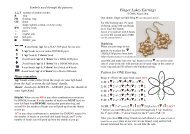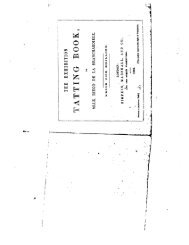HOW TO TAT LARGE RINGS AND LONG CHAINS THAT LOOK GOOD
HOW TO TAT LARGE RINGS AND LONG CHAINS THAT LOOK GOOD
HOW TO TAT LARGE RINGS AND LONG CHAINS THAT LOOK GOOD
You also want an ePaper? Increase the reach of your titles
YUMPU automatically turns print PDFs into web optimized ePapers that Google loves.
<strong>HOW</strong> <strong>TO</strong> <strong>TAT</strong> <strong>LARGE</strong> <strong>RINGS</strong> <strong>AND</strong> <strong>LONG</strong> <strong>CHAINS</strong> <strong>THAT</strong> <strong>LOOK</strong> <strong>GOOD</strong><br />
Copyright 2008 ‐ 2009 Ruth Perry<br />
Tatting, by the mathematical nature of the double stitch, curves around in loops and circles. It does this<br />
even if we don’t want it to! The field of mathematics called topology actually defines knots in math<br />
equations. OH NO!!! Not math! I know, a number of tatters reading this have just turned green, and<br />
then pale. You don’t have to be able to do the math to benefit from what it offers. Just like you don’t<br />
have to understand how a television set works to enjoy watching your favorite shows. Whew!<br />
We can tat loosly and end up with floppy rings and chains that require blocking and stiffening to hold<br />
their shape. Or we can have tatting that twists and ruffles and doesn’t have a lot of eye appeal. We can<br />
design with only smaller rings, and chains that curve, or short chains that will lie nearly straight.<br />
BUT… if we want to tat something with very large rings, or long chains, that is a terrible tatting trouble.<br />
Here is a Celtic Knot bat from the new book that I am working on with my great niece,<br />
Sarah Kelly. There are chains that are 60 stitches that bend in both directions. There<br />
are chains over 100 stitches long that curve around just so. I really struggled with the<br />
design of this piece, and my first 4 months of attempts were not pretty, and they will never be seen.<br />
They went directly into the circular file. Until – Eureka! My husband tied a sliding square knot for me.<br />
This is a knot used in rock climbing, and has been used in the military for hundreds of years.<br />
Here is the problem:<br />
The tatting double stitch, Figure 2,<br />
has the core thread with the knots<br />
made around it.<br />
Above the core thread there are 4<br />
cords in the knot. Below the core<br />
there are just 2. So when the stitches<br />
are pushed together there is an angle<br />
of about 12 degrees. This can be<br />
smiply pictured as how the hour and<br />
minute hands on a clock look at 2<br />
minutes before noon. That’s not a<br />
LOT of difference, unless we take that<br />
shape and put many of them side by<br />
side; like long tatted chains, and large<br />
rings.
A: Ring 35, Chain 35<br />
This looks nice, but notice that<br />
the chain curves into about the<br />
same shape as the ring.<br />
B: Ring 60, Chain 60<br />
The ring wants to “ruffle” or<br />
twist, and the chain curves<br />
around nearly twice. IT can be<br />
tatted loosly to make it lie flat,<br />
but then it is floppy, and must be<br />
stiffened and blocked to hold it<br />
in that shape.<br />
C: This is a BDS ring of 60<br />
stitches tatted with the<br />
Balanced Double Stitch<br />
Like the long chains in my bat,<br />
these stitches hold their shape<br />
without blocking or stiffening,<br />
and they do not ruffle, twist, or<br />
flop. Large rings are still<br />
challenging to close, and care<br />
must be taken to close them.<br />
In the book, The King and the Dragon, I am using the notation of Balanced Double Stitch, BDS, to<br />
indicate that something should be tatted with this variation of the tatting double stitch. The name<br />
states the function of the stitch, not the construction method.<br />
Here is the solution:<br />
This is a sliding square knot. Done in<br />
tatting, it’s a Balanced Double Stitch.<br />
There are 4 cords below the core<br />
thread, and 4 above, with the extra<br />
loops around the core sitting inside<br />
the waistband or bump of the stitch.<br />
Notice that there is much less of an<br />
angle to this knot. It can bend<br />
equally up or down. When many of<br />
them are pressed together they can<br />
be shaped straight, or in a curve in<br />
either direction. No stiffening or<br />
blocking is necessary.<br />
The BDS ring 60, shown above in C, is just 60 of this knot tatted tightly. The long chains in the bat are<br />
possible using this stitch, where as with a normal ds, they flipped, and flopped, and twisted all over and<br />
ended flopping the bat into the trash can!
How do I tat a BDS?<br />
For each half of the double stitch, go over and under the core thread a second time before tightening<br />
the half stitch. This is easy enough to do the way I learned shuttle tatting. I know there are at least 7<br />
different ways to shuttle tat, and probably not all of these tatters will find this easy to do.<br />
To tat the first half of the double stitch for either a ring or a chain I make a loop around my right<br />
(shuttle) hand, and then pass the shuttle under and back over the core thread on my left hand. To tat<br />
the second half of the ds I let a loop of thread hang down and pass the shuttle over then back under the<br />
core thread.<br />
To tat the BDS I make a loop around my shuttle hand, and then pass the shuttle under and back over<br />
and under and back over the core thread to make the first half of the BDS. To tat the second half of the<br />
BDS I let a loop of thread hang down and pass the shuttle over then back under and over then back<br />
under the core thread. In both the first and second half of the stitch, I do the remainder of the<br />
movements to snug the stitches flipped or unflipped exactly the same in both ds and BDS. It takes a bit<br />
of practice before this is easy.<br />
It can be done either with double stitches, and when tatting reverse (unflipped) stitches. Reverse<br />
stitches, R St, are also known as unflipped stitches, direct method, and larks head knots, and wrapping,<br />
and… whew, a lot of different terms for the same concept! We do not need multiple terms for the same<br />
thing, but as we all know tatting does not have much standardization – yet.<br />
Tatting the BDS in needle tatting is easy to do. Just wrap the thread around your finger two times<br />
instead of once and then put the tatting needle through the two wraps. Do this for each half of the<br />
stitch, and you will have the same effect as shuttle tatted BDS.<br />
The sliding square knot is used in rock climbing because if you hold onto the knot it will slide, but if you<br />
hold onto the ends it tightens and stops. Useful in getting safely up or down a mountain. In tatting it<br />
can be used to solve the problem of the extreme curve in long chains and large rings.<br />
It is my desire to share this technique with tatters everywhere. Please share this document freely, teach<br />
the technique, and design patterns using the BDS. I would appreciate a copy of any publication that<br />
includes this document or any portion of this document. Updates will be posted on my website:<br />
http://rozellalinden.com<br />
Also see: Auld, Rhoda, Tatting the contemporary art of knotting with a shuttle, Van Nostrand Reinhold,<br />
1974. The rings pp. 84 & 85 Variations in Rings; Fig. 6‐3 d & e are tatted using the same construction<br />
method as the BDS examined here. Rhoda Auld (1925 – 2002) was a tatter and author of this book on<br />
tatting and a book on Molas. Her husband, Lawrence Auld, did the photography. She wrote this<br />
wonderful book while they lived in Oregon where they had access to tatting in museums and private<br />
collections and were given permission to photograph the pieces for this book. In the preface of the<br />
book she states, “It is the purpose of this book to show that tatting has a future as well as a past.”<br />
I heartily recommend this book for inclusion of every tatter’s personal library! It holds many more<br />
treasures that modern tatters will find both interesting and useful.


